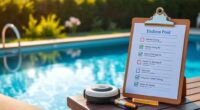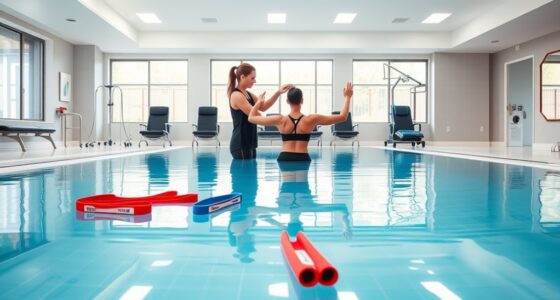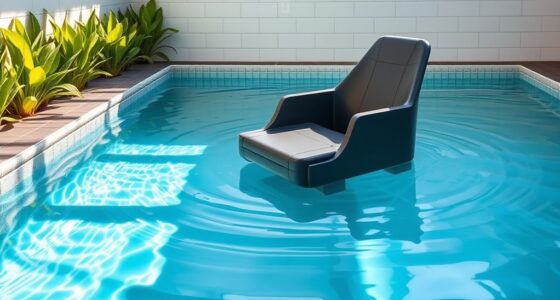To optimize triathlon training in an endless pool over six weeks, focus on building a solid foundation, then gradually increase intensity with interval training and speed drills. Incorporate brick workouts and practice shifts to mimic race conditions. Prioritize recovery strategies and monitor your progress to prevent overtraining. As you prepare for race day, fine-tune your technique and mental readiness. Keep pace with this adaptable plan to elevate your performance—more details follow to help you succeed.
Key Takeaways
- Follow a structured 6-week plan focusing on endurance, speed, and race simulation using adjustable jets and performance metrics.
- Incorporate interval training, efficiency drills, and stroke optimization to improve technique and stamina in the Endless Pool.
- Practice brick workouts and quick transitions to prepare for multi-discipline race demands effectively.
- Use data tracking and AI analysis to monitor progress, adjust intensity, and prevent overtraining or injury.
- Prioritize recovery, nutrition, and mental preparation during the final week to ensure optimal race readiness.
Setting Up Your Endless Pool for Optimal Triathlon Training
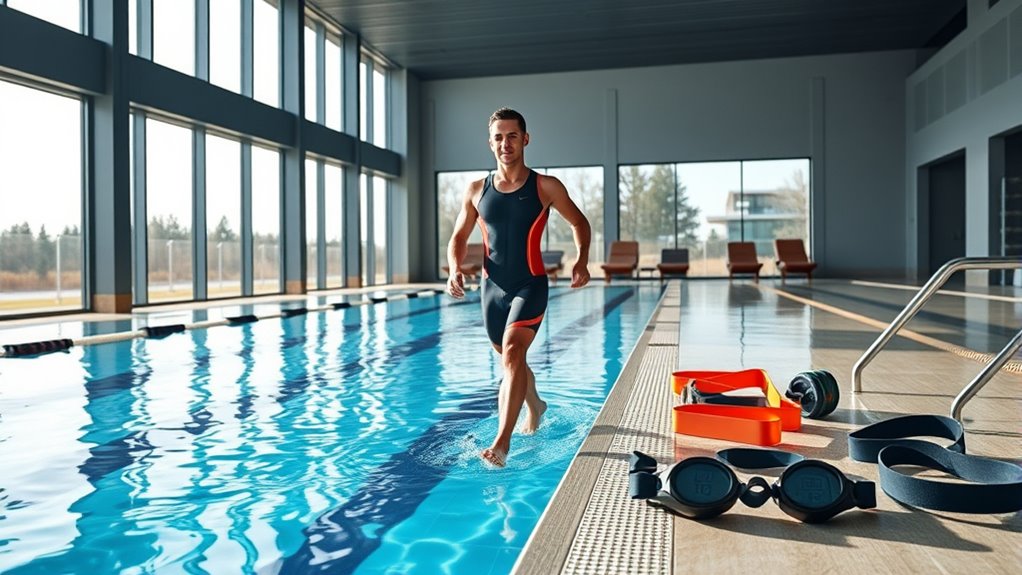
To maximize your triathlon training in an endless pool, start by verifying the setup mimics open-water conditions as closely as possible. Adjust the water temperature to around 78-82°F—ideal for comfort and endurance. Use adjustable jets or current generators to create a steady, consistent flow that simulates open-water swimming. Position your lane to minimize reflections and turbulence, replicating the feeling of swimming in a natural environment. Install proper lighting to reduce glare and improve visibility, helping you stay focused. Keep your pool clean and well-maintained to prevent disruptions during training. Consider adding waterproof speakers for music or coaching cues, and ensure your equipment, like goggles and swimwear, are suited for pool conditions. Proper setup fuels effective, realistic training sessions. Additionally, understanding the importance of contrast ratio can help you select a projector that provides clear, detailed images in your home cinema setup.
Week 1: Building a Foundation With Technique and Endurance

Starting your first week in the endless pool is all about establishing a strong foundation in technique and building your endurance. Focus on maintaining proper form in each stroke and kick, paying attention to body position, breathing, and arm movement. Keep your pace steady and manageable to develop consistent endurance without overexertion. Use this time to familiarize yourself with the water and your equipment, ensuring smooth progressions between drills. Incorporate drills that emphasize efficiency, such as catch-up or fingertip drag, to improve your technique. Remember, the goal is to build confidence and a solid base, so prioritize quality over speed. This week sets the stage for more intense workouts later, so take your time and stay mindful of your form. Additionally, understanding training techniques can help optimize your workout effectiveness and prevent injury.
Week 2: Increasing Intensity and Incorporating Interval Work

As you progress into Week 2, it’s time to ramp up the intensity and introduce interval training to boost your speed and stamina. Incorporate short bursts of high effort followed by recovery periods to challenge your body and improve performance. Focus on maintaining proper technique during these intense intervals to maximize effectiveness. Here’s a sample plan:
| Interval Type | Duration | Rest Period |
|---|---|---|
| Sprint | 30 seconds | 30 seconds |
| Moderate Pace | 1 minute | 1 minute |
| Max Effort | 20 seconds | 40 seconds |
| Steady State | 2 minutes | 2 minutes |
| Cool Down | 5 minutes | — |
This structure helps build speed, endurance, and recovery capacity efficiently. Incorporating training intensity strategies can further enhance your overall performance.
Week 3: Focused Speed Work and Stroke Efficiency
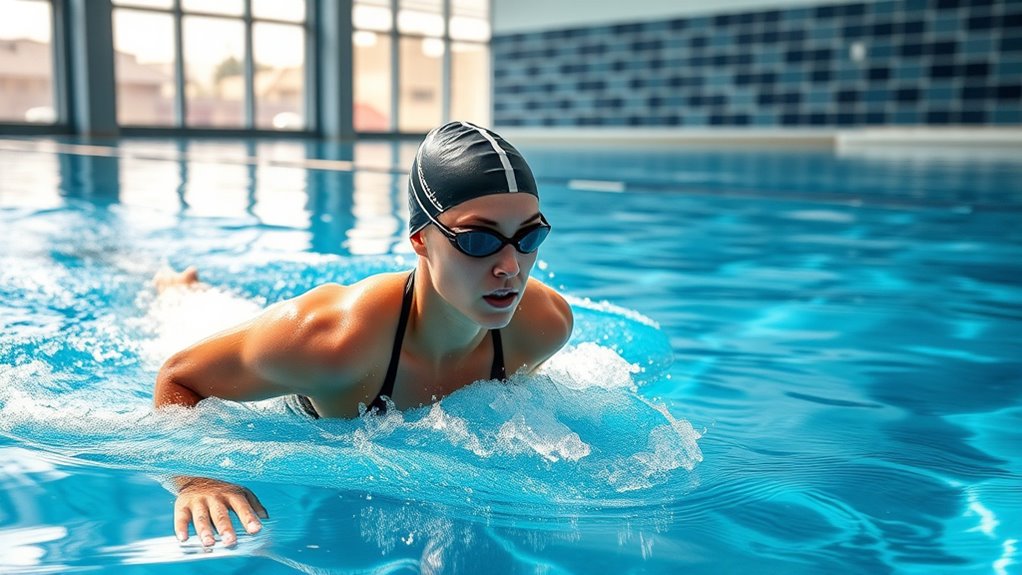
This week, you’ll concentrate on speed interval sessions to push your limits and improve pace. Incorporate stroke technique drills to enhance efficiency and reduce energy waste. Keep a close eye on your performance metrics to track progress and make real-time adjustments. Additionally, integrating innovative training tools like AI-powered analysis can provide valuable insights into your form and help optimize your training regimen.
Speed Interval Sessions
To enhance your speed and stroke efficiency in the pool, incorporating targeted speed interval sessions into your training is essential. These sessions push your limits and improve your overall pace. Focus on short, intense efforts with rest intervals to maximize power and recovery. For example, swim 8×50 meters at near-max effort, resting 20 seconds between each. This trains your body to sustain high speeds and improves stroke mechanics under fatigue. To help plan your sessions, consider this structure:
| Interval Type | Description |
|---|---|
| Sprint Intervals | 25-50 meters at maximum effort, rest 15-30 sec |
| Threshold Intervals | 100 meters at high but sustainable pace, rest 30 sec |
| Speed Endurance Sets | 200 meters at race pace, rest 1 min |
| Recovery Swims | Easy swimming for active recovery |
Stroke Technique Drills
Building on your speed interval sessions, refining your stroke technique during focused drills can substantially boost your efficiency and race pace. Concentrate on smooth, controlled movements that maximize propulsion while minimizing drag. Focus on maintaining a steady rhythm, a high elbow catch, and a strong core to improve your overall glide. Incorporate drills like fingertip drag, catch-up, and single-arm swims to target specific areas of your stroke. Consistent practice will help you develop muscle memory, ensuring your form remains efficient even under fatigue. Remember, small adjustments can lead to significant gains, so stay attentive to your technique. Using detailed micro-adjustments can further enhance your efficiency and help you fine-tune your form.
Monitoring Performance Metrics
How can you guarantee your speed work and stroke efficiency sessions are truly effective? The key is monitoring your performance metrics consistently. Use tools like waterproof GPS watches or swim-specific apps to track your pace, stroke rate, and distance accurately. Pay attention to stroke count per lap and your heart rate to gauge effort levels. Recording these metrics after each session helps identify progress and areas needing improvement. Focus on maintaining consistent stroke efficiency and adjusting your intensity based on data insights. Regularly reviewing your performance allows you to set realistic goals and measure improvements over time. Remember, precise monitoring turns subjective feelings into objective data, making your training smarter and more targeted. Incorporating data-driven strategies can further enhance your training effectiveness. This approach ensures you’re maximizing every session for optimal results.
Week 4: Integrating Brick Workouts for Triathlon Specificity

Integrating brick workouts into your training routine is essential for developing the specific muscle memory and shift skills needed for a successful triathlon. These workouts simulate race conditions by combining cycling and running, helping your body adapt to the quick transition between disciplines. During Week 4, focus on pairing your bike session immediately followed by a run, even if you’re training indoors. This practice sharpens your mental readiness and improves your overall efficiency.
Feel the thrill of progress as you:
- Build confidence in your ability to switch seamlessly between sports
- Strengthen muscles used in both cycling and running, reducing fatigue
- Experience the exhilaration of real race scenarios, boosting motivation
Week 5: Fine-Tuning Performance and Recovery Strategies

This week, you’ll focus on refining your recovery techniques to keep your body fresh and ready. You’ll also adjust workout intensity based on your performance metrics to avoid burnout. Monitoring these metrics helps you identify areas for improvement and guarantee you’re training effectively.
Optimizing Recovery Techniques
To optimize your recovery techniques, you need to focus on strategic methods that promote muscle repair, reduce fatigue, and prevent injury. Restorative practices allow your body to recover fully, ensuring you’re ready for the next training session. Incorporate active recovery, such as light swimming or stretching, to boost circulation and accelerate healing. Pay attention to nutrition—fuel your body with anti-inflammatory foods and stay hydrated. Prioritize sleep, as it’s essential for muscle repair and mental clarity. Additionally, choosing the right office chair for neck pain relief can help maintain proper posture during post-training recovery periods.
Fine-Tuning Workout Intensity
Fine-tuning your workout intensity during Week 5 is essential for maximizing performance gains while minimizing the risk of overtraining or injury. Focus on adjusting your effort levels based on how you feel and your recent training response. Incorporate a mix of high-intensity intervals, steady-state sessions, and active recovery to optimize adaptation. Pay attention to your body’s signals—if you notice excessive fatigue or soreness, dial back the intensity. Use perceived exertion to guide your effort, aiming for challenging but sustainable efforts during key sessions. Avoid pushing too hard on every workout; instead, prioritize quality and consistency. This fine-tuning helps you develop stronger endurance, speed, and resilience, setting a solid foundation for the final week of your training plan. Recognizing the importance of dog breeds and their traits can also inspire new ways to approach your training routines, ensuring variety and motivation throughout your fitness journey.
Monitoring Performance Metrics
Monitoring your performance metrics during Week 5 provides critical insights into how your body responds to training and recovery efforts. By tracking key data, you can identify strengths, weaknesses, and signs of overtraining. This awareness helps you adjust your routine for maximum progress and injury prevention.
Focus on metrics like heart rate variability, pace consistency, and perceived exertion to gauge your readiness. Analyzing this data can boost your confidence, motivate you to push further, or signal when to rest. Regularly reviewing your performance data can help you make informed decisions about your training adjustments.
- Feel the thrill of seeing your progress unfold, fueling your determination.
- Recognize early signs of fatigue before they become setbacks.
- Celebrate small victories that keep your training exciting and rewarding.
Week 6: Preparing for Race Day and Final Tips
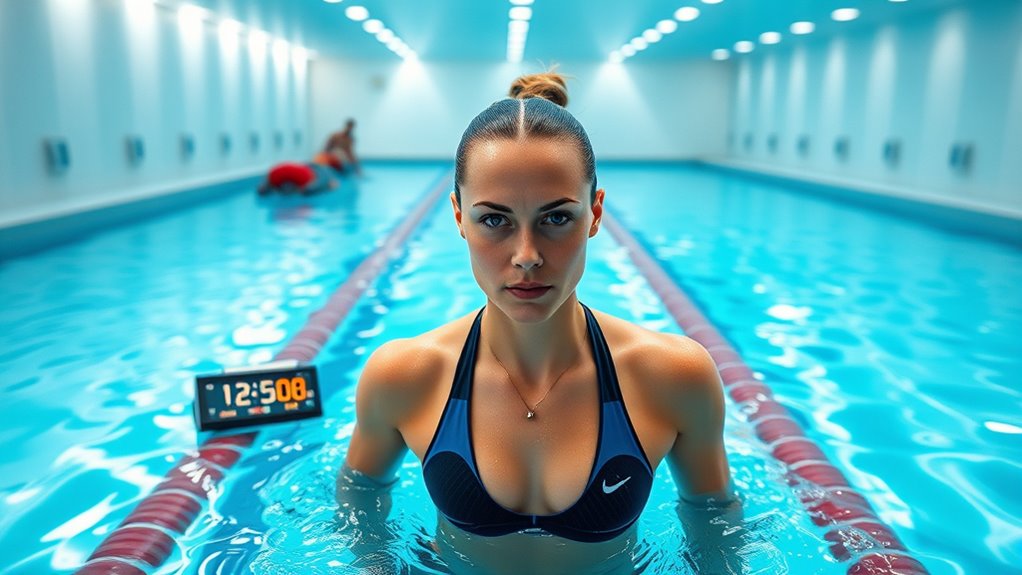
Are you confident that your race-day plan is fully in place? This final week is about fine-tuning your strategy and ensuring you’re mentally prepared. Review your nutrition and hydration plan, making sure you have everything ready and familiar with your race-day gear. Rest is essential now—avoid overtraining and prioritize sleep to maximize recovery. Visualize your race, going through each stage confidently. Practice your transitions briefly to keep them smooth, but don’t fatigue yourself. Trust your training and stay positive. Remember, race day is about total-cost clarity and focus, not perfection. Stay calm, breathe deeply, and remind yourself that you’ve prepared thoroughly. With everything in place, you’ll approach race day ready to perform your best. Good luck!
Frequently Asked Questions
How Do I Prevent Boredom During Long Indoor Swim Sessions?
To prevent boredom during long indoor swim sessions, mix up your workouts with different drills, intervals, and strokes. Use music or podcasts to keep your mind engaged. Set small goals or challenges to stay motivated, and vary your pacing throughout the session. Incorporate visual cues or timers to track progress. Changing your routine regularly keeps things fresh and helps maintain your focus and enthusiasm during those extended indoor swims.
What Are the Best Accessories to Enhance My Endless Pool Workouts?
Think of your endless pool as a playground, and the right accessories as your secret tools. Use kickboards to focus on leg strength, pull buoys to improve upper body, and waterproof headphones to keep your mind engaged. Resistance paddles and fins add variety, turning each session into a new adventure. These accessories make your workout more dynamic, preventing boredom and helping you stay motivated while sharpening your triathlon skills.
How Can I Simulate Open Water Conditions in My Pool Training?
You can simulate open water conditions by adding a waterproof speaker to play outdoor sounds like waves or splashing water. Use a swim tether to create resistance, mimicking currents, and vary your pacing to replicate open water starts and sprints. Wear goggles that simulate saltwater glare, and practice sighting by occasionally looking forward. These strategies help you adapt to open water challenges right in your pool.
What Safety Precautions Should I Follow During High-Intensity Intervals?
Think of high-intensity intervals as lightning strikes—powerful but dangerous if you’re unprepared. To stay safe, always warm up thoroughly, listen to your body, and avoid pushing through pain. Make certain your pool area is dry and free of obstacles, and never train alone—have someone nearby in case of emergencies. Use proper gear, stay hydrated, and know your limits to prevent injury and ensure a safe, effective workout.
How Do I Track Progress Effectively With Limited Equipment?
You can track progress effectively by keeping a detailed training log, noting your workout specifics, times, and how you feel during each session. Use a waterproof stopwatch or fitness tracker to monitor your pace and heart rate during swim sessions. Regularly assess your performance with time trials or distance goals, and compare these metrics week-to-week. This approach helps you identify improvements and adjust your training plan accordingly.
Conclusion
As you finish this six-week journey, picture yourself gliding effortlessly through the water, each stroke confident and smooth. Feel the strength you’ve built, the sweat and determination fueling your progress. With every training session, you’re shaping not just your body but your mindset for race day. Trust in your preparation—soon, you’ll cross that finish line, your heart pounding with pride. This endless pool has transformed you into a triathlete ready to conquer any challenge.

